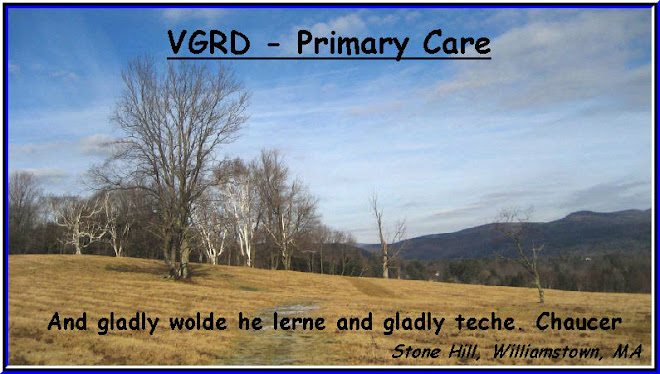Presented by: Charles LaGoy, MS IV
University of New England College of Osteopathic Medicine
Abstract: 57 yo man with one year history of a painful nodule on helix.
History: This retired jockey presented to the dermatologist for a general skin exam and incidental complaint of a painful nodule on the left ear helix which had interfered with his sleep. He had not sought treatment for this previously. Patient is recovering from a Whipple procedure performed after a pancreatic condition left him unable to eat without great pain and subsequent weight loss of 45 lbs from his normal weight of approximately 115 lbs.
University of New England College of Osteopathic Medicine
Abstract: 57 yo man with one year history of a painful nodule on helix.
History: This retired jockey presented to the dermatologist for a general skin exam and incidental complaint of a painful nodule on the left ear helix which had interfered with his sleep. He had not sought treatment for this previously. Patient is recovering from a Whipple procedure performed after a pancreatic condition left him unable to eat without great pain and subsequent weight loss of 45 lbs from his normal weight of approximately 115 lbs.
O/E: Tender nodule approximately 4mm in diameter on superior aspect of left ear helix. Some erosion with scaling at site.
Clinical Photo(s): These are representative photos since we did not take pictures of this man.


Easily constructed foam ear guard.

Lab: n/a


Easily constructed foam ear guard.

Lab: n/a
Histopathology: n/a
Diagnosis or DDx: Chondrodermatitis nodularis chronica helicis - CNH (A.K.A. painful nodule of the ear)
Diagnosis or DDx: Chondrodermatitis nodularis chronica helicis - CNH (A.K.A. painful nodule of the ear)
Questions: n/a
Reason Presented: The primary care physician is likely to encounter (CNH), also known as painful nodule of the ear. The condition is most common in males over 50 years old (1), with a male to female ratio of 10:1(2) It is thought that minor trauma to the small blood vessels supplying the pinna (1), perhaps coupled with exposure to solar radiation (3), leads to tissue damage and that inadequate blood supply prevents healing (1).
While Fitzpatrick’s Dermatology text notes that surgical excision is the definitive treatment (1), a recent small study by Moncrieff and Sassoon suggests that mechanical protection of the site is an effective conservative treatment with a lower recurrence rate than surgery (4). Their described treatment gave the patients significant leeway in designing a method of protecting the pinna from pressure while sleeping (3rd photo). The results were good with only a 13% failure rate compared to a 34% recurrence rate within a mean of 13 weeks for the surgery group (4).
The establishment of the diagnosis of CNH was left to clinical judgment in this study, whereas other authors believe that a biopsy is always required to rule out a neoplastic process (2). It is likely that this belief would complicate a decision to treat conservatively, as it might be reasonable to excise the entire nodule during the biopsy. However, a clinician with confidence in the diagnosis would likely serve the patient well by presenting the conservative treatment of these lesions, holding biopsy and/or excision for those cases that fail to respond adequately.
Reason Presented: The primary care physician is likely to encounter (CNH), also known as painful nodule of the ear. The condition is most common in males over 50 years old (1), with a male to female ratio of 10:1(2) It is thought that minor trauma to the small blood vessels supplying the pinna (1), perhaps coupled with exposure to solar radiation (3), leads to tissue damage and that inadequate blood supply prevents healing (1).
While Fitzpatrick’s Dermatology text notes that surgical excision is the definitive treatment (1), a recent small study by Moncrieff and Sassoon suggests that mechanical protection of the site is an effective conservative treatment with a lower recurrence rate than surgery (4). Their described treatment gave the patients significant leeway in designing a method of protecting the pinna from pressure while sleeping (3rd photo). The results were good with only a 13% failure rate compared to a 34% recurrence rate within a mean of 13 weeks for the surgery group (4).
The establishment of the diagnosis of CNH was left to clinical judgment in this study, whereas other authors believe that a biopsy is always required to rule out a neoplastic process (2). It is likely that this belief would complicate a decision to treat conservatively, as it might be reasonable to excise the entire nodule during the biopsy. However, a clinician with confidence in the diagnosis would likely serve the patient well by presenting the conservative treatment of these lesions, holding biopsy and/or excision for those cases that fail to respond adequately.
References:
1) Freedberg I, et al. Eds, Fitzpatrick's Dermatology in General Medicine, 6th ed. New York, McGraw-Hill 2003
2) Avitia S, Hamilton J, Osborne R, Chondrodermatitis nodularis chronica helicis. Ear, Nose and Throat Journal 2005 Jul 84(7) P406-407
3) Goette D, Chondrodermatitis nodularis chronica helicis: a perforating necrobiotic granuloma. Journal of the American Academy of Dermatology, 1980 Feb; 2(2):148-54
4) Moncrieff M, Sassoon E, Effective treatment of chondrodermatitis nodularis chronic helicis using a conservative approach. British Journal of Dermatology, 2004; 150: 892-894




